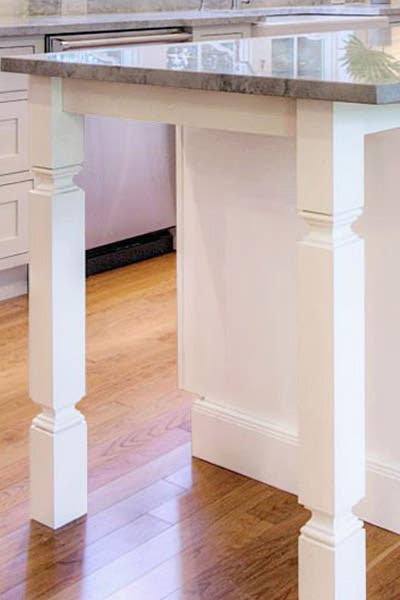Achieve an Advanced Appearance Using Ornate Legs For Kitchen Island Styles
Achieve an Advanced Appearance Using Ornate Legs For Kitchen Island Styles
Blog Article
Vital Aspects to Think About When Choosing Legs For Kitchen Island
Choosing the appropriate legs for a kitchen area island involves a cautious analysis of several variables that can considerably affect both functionality and visual allure. As we check out these components, it becomes clear that each decision can have far-ranging implications for the general cooking area experience.
Material Options
When choosing legs for a cooking area island, understanding the different product options is necessary for achieving both aesthetic charm and architectural integrity (Legs For Kitchen Island). The option of product dramatically influences not only the toughness of the island yet also its general style and capability
Wood is a popular option, supplying warmth and flexibility. Solid hardwoods, such as oak or maple, supply toughness and can be tarnished or painted to match the kitchen decoration. Steel legs, typically made from stainless-steel or functioned iron, add a modern-day and commercial feel while ensuring resilience and stability. These materials are resistant to use and can support considerable weight, making them suitable for bigger islands.
An additional alternative is crafted materials, like MDF or plywood, which can be much more affordable while still offering a variety of coatings. They may not offer the exact same degree of stability as solid timber or metal. Legs For Kitchen Island. Lastly, products such as acrylic or glass can develop a contemporary appearance, though they may need additional support to guarantee stability.
Inevitably, the choice of material for cooking area island legs must align with the wanted performance and the overall motif of the kitchen area.
Design and Style

When thinking about design, the form and surface of the legs are important. Conical legs can give a feeling of agility and style, while thicker, extra durable legs can share toughness and security. In addition, the coating-- be it repainted, discolored, or natural-- ought to match the cabinets and countertop materials to create a unified appearance.
In addition, the layout of the legs can additionally show personal taste. Custom or decorative legs, such as those including complex makings or distinct geometric shapes, can work as centerpieces, including character and personality to the cooking area. Inevitably, the ideal option will not just improve functionality but additionally raise the aesthetic allure, making the cooking area island a standout function of the home.
Height Factors To Consider
Selecting the proper elevation for cooking area island legs is important, as it straight impacts both functionality and comfort. The basic height for a kitchen area island usually ranges from 36 to 42 inches, lining up with common kitchen counter elevations.

It is also vital to represent users' elevations and preferences. Personalizing the height can make certain a comfy experience for all family participants, making the kitchen area island a more functional and delightful area.
Weight Assistance
Ensuring sufficient weight assistance for kitchen area island legs is essential for both security and capability. The kitchen area island frequently offers multiple objectives, including cooking, dining, and added storage, demanding a robust assistance framework. When choosing legs, my explanation it is critical to think about the total weight capability called for based on the island's meant usage and the materials that will certainly be positioned on it.
The option of product for the legs plays a significant function in their weight-bearing capacities. Solid timber, steel, and heavy-duty compounds usually offer premium strength compared to lighter products. In addition, the design of the legs-- whether they are directly, tapered, or have a pedestal kind-- can influence their ability to distribute weight successfully throughout the structure.
Always speak with the producer's specs relating to tons limitations to guarantee that the legs can sustain the intended weight without compromising safety. In recap, picking cooking area island legs with ample weight assistance is necessary for creating a useful and secure cooking area.
Installation and Maintenance
Correct installment and upkeep of cooking area island legs are important for making sure durability and stability. To start, it is vital to comply with the producer's guidelines throughout setup. This frequently involves safeguarding the legs to the island base using ideal fasteners, ensuring that the legs are degree and lined up. Utilizing a degree tool can aid stop wobbling and boost the general visual charm of the kitchen island.
As soon as set up, normal upkeep is essential to preserve the integrity and look of the legs - Legs For Kitchen Island. For wood legs, periodic cleansing with a wet fabric and application of ideal wood gloss can prevent wetness damages and maintain their finish. Steel legs might require a mild cleansing service to get rid of grease and gunk, adhered to by a completely dry cloth to avoid rust development
Furthermore, evaluate the legs routinely for indications of wear or damages, such as fractures or loosened joints. Tightening up screws or screws as required can additionally prolong the life expectancy of the legs. By adhering to these installment and upkeep methods, property owners can make sure that their cooking area island continues to be tough and aesthetically appealing for years to come.
Conclusion

Aesthetic coherence is vital in picking the style and design of legs for a kitchen area island, as these aspects substantially influence the overall ambiance of the area. Conical legs can provide a sense of lightness and sophistication, while thicker, a lot more durable legs can share strength and stability.Choosing the suitable height for kitchen area island legs is vital, as it straight influences both functionality and comfort. In summary, selecting kitchen island legs with sufficient weight support is vital for producing a click site practical and risk-free culinary area.
In final thought, picking legs for a kitchen island necessitates mindful factor to consider of numerous variables, consisting of product choices, style, height, weight assistance, and installment.
Report this page